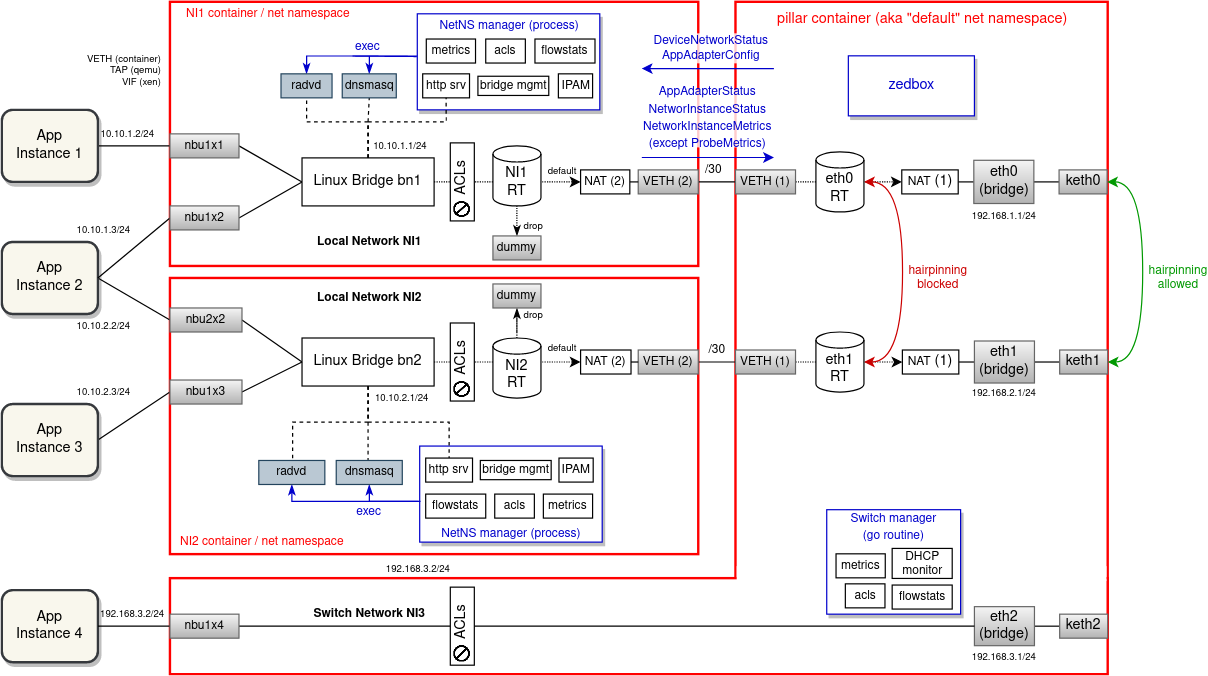Background and Motivation
Currently we keep the EVE device networking and the different network instances for application networking separated using a combination of IP rules (PBR = policy based routing) and ACLs (iptables).
...
We can get better separation, including IP address isolation if we split network instances using either VRFs or with network namespaces. Furthermore, if we use a containerd task to run network instance networking (especially the external processes like dnsmasq, radvd, etc.), we can even isolate resource usage and apply limiting. We will now describe VRFs and network instances separately, with a bit more focus on VRFs, which, after some internal discussion, are now the preferred choice.
VRF Proposal
VRF device combined with IP rules provides the ability to create virtual routing and forwarding domains (aka VRFs, VRF-lite to be specific) in the Linux network stack. VRF essentially provides a light-weight L3-level (and above) isolation, i.e. multiple interfaces can have the same IP address assigned if they are inside different VRF domains and, similarly, multiple processes can listen on the same IP address. Compare that with network namespaces, which provide a full device-level isolation, but at a cost of a higher overhead and with additional challenges for the management plane (see "Network Namespaces" below).
...
With this, it will be possible to deploy multiple VPN network instances with overlapping traffic selectors and still route/encrypt/decrypt unambiguously.
Network Namespaces (alternative proposal)
An alternative solution to VRFs is that instead of using per-NI VRF and CT zone, we could isolate on all network levels and run each Linux bridge and associated network interfaces plus external processes (dnsmasq, radvd, strongSwan ...) in a separate network namespace. For every new network instance zedrouter would create a new named network namespace (alternatively it could start a new containerd task with its own network namespace), connected with the "default" net namespace using a VETH pair. Downlink interfaces have to be moved into the target network namespace before they are put under the bridge. The bridge part is currently done by hypervisors (veth.sh for containers, qemu & xen allow to specify bridge in the domU config). This would be removed and we would instead finalize downlink interface configuration ourselves in doActivateTail() of domain manager.
...
The following diagram shows how network instances could be isolated from each other using network namespaces. As it can be seen, not only the network configuration is spread across namespaces, but also the management plane is split into multiple processes (all of which increases complexity and overhead, thus making this proposal less appealing).
Proof of Concept
In order to verify that the proposed network configuration would actually work for all scenarios as intended, a PoC based on docker containers representing network stacks of (mock) apps, network instances and zedbox has been prepared. The source code for the PoC with diagrams and description can be found in this repository: https://github.com/milan-zededa/evenet
...
For VETHs, subnets 127.0.0.0/8 and 0.0.0.0/8 sadly failed the validation - routing does not work as expected/desired (even if the local table is tweaked in various ways). On the other hand, 169.254.0.0/16 and 240.0.0.0/4 can be routed between network namespaces and VRFs without issues. But for 169.254.0.0/16 we need to select a subnet that does not contain 169.254.169.254, which is already used for the HTTP server with cloud-init metadata. After some internal discussion, we are more inclined to allocate VETH IPs from the (most likely) forever-reserved Class E subnet 240.0.0.0/4.
Development Steps (VRF Proposal)
| No Format |
|---|
PR 1:
* Build Linux kernel with VRF support
= https://www.pivotaltracker.com/story/show/178785411
PR 2:
* LD-PRELOAD library for VRF-unaware processes
= https://www.pivotaltracker.com/story/show/178785483
- or test 'ip vrf exec' as an alternative
PR 3:
* Eden test for local networks with overlapping IP subnets
= https://www.pivotaltracker.com/story/show/178785541
- without VRFs this test will be failing (i.e. would not be merged until PR 4 is done)
PR 4:
* Local & Switch Network instance (Create/Modify/Delete)
= https://www.pivotaltracker.com/story/show/178785641
* ACLs
= https://www.pivotaltracker.com/story/show/178785656
* Flow collection
= https://www.pivotaltracker.com/story/show/178785689
* Network instance metrics
= https://www.pivotaltracker.com/story/show/178785716
PR 5:
* Eden test for VPN networks with overlapping traffic selectors
= https://www.pivotaltracker.com/story/show/178785745
- without VRFs this test will be failing (i.e. would not be merged until PR 6 is done)
PR 6:
* VPN Network instance
= https://www.pivotaltracker.com/story/show/178785793 |
...

